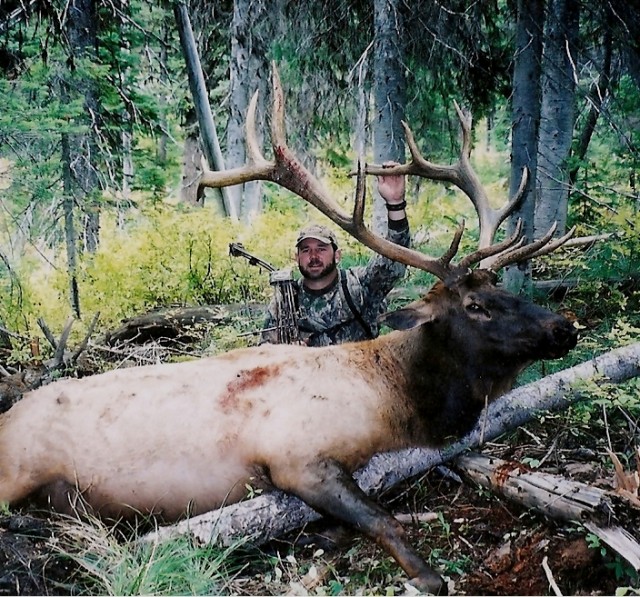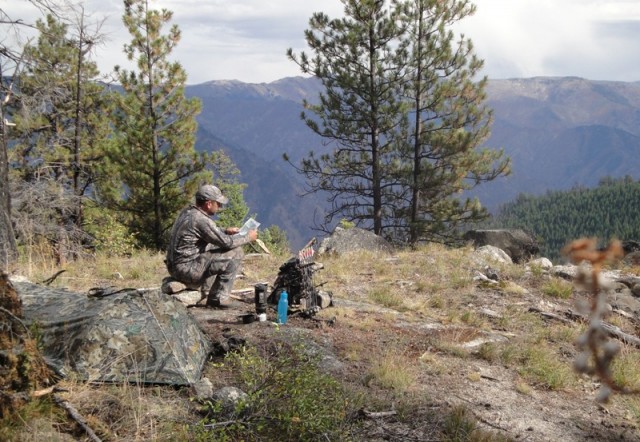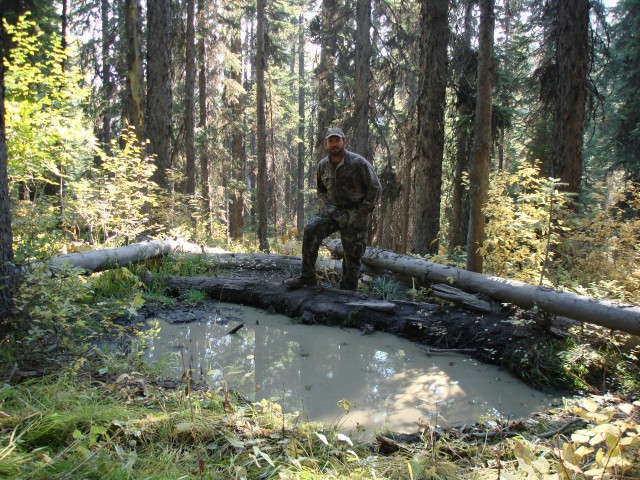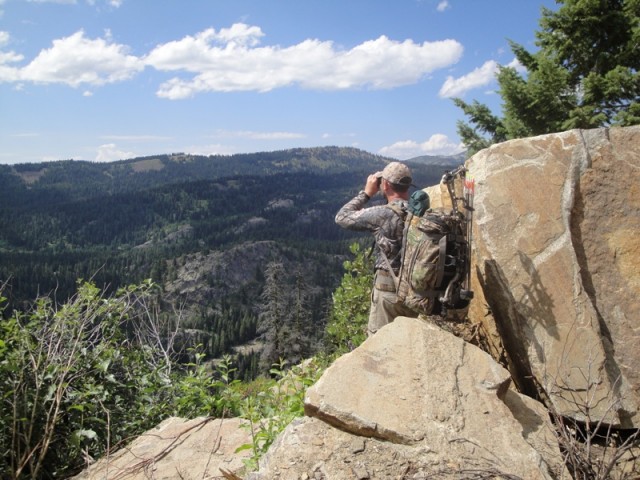Hunting the Rut
 I always enjoy hunt talk and my favorite topic has to be elk hunting during the rut. September is a special time for us bowhunters and lucky rifle hunters that have the opportunity to hunt during the bugle season. One of the questions I’m often asked is in reference to hunting techniques during the course of the rut. “What techniques work the best during the pre, peak, and post-rut?” I have been a very avid bowhunter since the early 90’s and have never missed an archery season. I have logged hundreds of encounters and have been blessed with great success elk hunting here in Idaho. I have seen, smelt, heard, and felt things that still get my blood going whenever re-living those experiences. From pre-rut to post-rut, September is my favorite time to be in the woods…and in my opinion there isn’t a sure-fire technique to get every bull within range.
I always enjoy hunt talk and my favorite topic has to be elk hunting during the rut. September is a special time for us bowhunters and lucky rifle hunters that have the opportunity to hunt during the bugle season. One of the questions I’m often asked is in reference to hunting techniques during the course of the rut. “What techniques work the best during the pre, peak, and post-rut?” I have been a very avid bowhunter since the early 90’s and have never missed an archery season. I have logged hundreds of encounters and have been blessed with great success elk hunting here in Idaho. I have seen, smelt, heard, and felt things that still get my blood going whenever re-living those experiences. From pre-rut to post-rut, September is my favorite time to be in the woods…and in my opinion there isn’t a sure-fire technique to get every bull within range.
Pre-Rut
If you are blessed with the time to scout pre-season, then the pre-rut might just might be your best bet for putting an elk on the ground. I consider pre-rut to be from mid August to the first week of September. The bulls at this time can be more easily patterned. If you can determine travel patterns and water sources then tree stand and/or ground blinds may be an option. Pre-season trail cams can be a great help in logging activity. Always pay attention to wind to determine stand/blind location while scouting. Once you find these key locations and are confident in the set up, slip in and place your stand/blind.
 Once hunting, don’t be afraid to call if activity is slow, as this might bring a curious bull within range. I personally am more likely to be the guy that just covers a lot of country. I try to stay high on the ridges glassing and calling to find the bulls that want to bugle. By the time season opens, harems have already been gathered and if you cover enough country you will find a responsive bull. I am quite often backpacked in, sleeping on a ridge, listening through the night to the bulls I hunt. Age class bulls are more likely to bugle during the pre-rut so if you hear one, get after him.
Once hunting, don’t be afraid to call if activity is slow, as this might bring a curious bull within range. I personally am more likely to be the guy that just covers a lot of country. I try to stay high on the ridges glassing and calling to find the bulls that want to bugle. By the time season opens, harems have already been gathered and if you cover enough country you will find a responsive bull. I am quite often backpacked in, sleeping on a ridge, listening through the night to the bulls I hunt. Age class bulls are more likely to bugle during the pre-rut so if you hear one, get after him.
After hearing a bugle I always get as close as I can without calling. I always try and get on their elevation while moving in downwind. I make my best guess on the shooting set-up after moving in as close as I dare, then call without being very aggressive. After giving one high to low mild bugle I wait for the response. Every situation is different. On occasion the bull will come in immediately to investigate and if you’ve played the wind and set up properly, you might be packing meat for the next several hours. Bulls will most likely bugle early morning this time of season so plan on covering country and bugling well before light. The temperatures are normally higher this time of year so don’t be surprised if the activity is short-lived. I have, however, had incredible bugling early afternoon, on south facing slopes, in 85-degree temperatures on opening day. In this case, two age class bulls were competing for the same group of cows. It was an incredible hunt. This can happen anytime during the season. None of us can determine when the switch is going to flip and the bugling will come alive. All of a sudden, bugles fill the canyons and sign is everywhere while we are scratching our heads wondering where all the elk were hiding.
Peak-Rut
 Once the switch is flipped the bugling increases and can greatly add to the active hunting hours. As the pre-rut transforms to the peak-rut you can expect to hear bugling most of the day. The younger bulls will soon join in with their own bugles while trying to attract a curious cow. Again, I am covering country trying to find that mature bull. I have found the herd bulls, even while bedded, will periodically bugle letting their competition know who’s king of the canyon. This is one of my favorite times to hunt elk. For the past several years I have had success stalking in on bedded bulls. Once I know the bull is not likely going to leave his cows for my challenging bugles I will follow the herd to their bedding area. When I feel they are settled in for the day and the thermals are consistent I plan my approach. I always try to get on the same elevation while moving in without calling. I use the periodic calls of the bull to lead me to his location. This sometimes takes a lot of patience if the bugles are few and far between. When hunting with a partner, one guy can stay back and call enough to keep the bull calling. If the bull is active you can move in rather quickly.
Once the switch is flipped the bugling increases and can greatly add to the active hunting hours. As the pre-rut transforms to the peak-rut you can expect to hear bugling most of the day. The younger bulls will soon join in with their own bugles while trying to attract a curious cow. Again, I am covering country trying to find that mature bull. I have found the herd bulls, even while bedded, will periodically bugle letting their competition know who’s king of the canyon. This is one of my favorite times to hunt elk. For the past several years I have had success stalking in on bedded bulls. Once I know the bull is not likely going to leave his cows for my challenging bugles I will follow the herd to their bedding area. When I feel they are settled in for the day and the thermals are consistent I plan my approach. I always try to get on the same elevation while moving in without calling. I use the periodic calls of the bull to lead me to his location. This sometimes takes a lot of patience if the bugles are few and far between. When hunting with a partner, one guy can stay back and call enough to keep the bull calling. If the bull is active you can move in rather quickly.
With senses on full alert I will move in as if stalking a bedded mulie. On occasion I am lucky enough to stalk all the way in for a shot. In most cases I can get into bow range, but because of cover, do not have a shooting lane. I have spent countless hours within bow range of big bulls. If a shooting opportunity doesn’t naturally present itself while they are getting up from their beds, I will bugle and/or cow call to coax the bull into a shooting lane. Of course, it often ends up without an arrow in the air, but it’s sure more fun than hanging out at the tent for the afternoon. Don’t get me wrong, there is nothing like bugling a big bull into bow range, but the technique I have described works well with those bigger bulls that just won’t leave their cows during the peak of the rut.
Post-Rut
 As the rut seems to settle there is a definite lull in the bugling. No one knows when exactly that will be, but most of us have experienced some slow days toward the end of the season. This is the period where most of the breeding has been done and several of the herd bulls are in need of some serious rest. Once again, I’m still covering the country calling, trying to find that active bull. At anytime a yearling or second cycle cow can come into estrus causing post-rut competition. The bugling can become intense and create great opportunity. Don’t give up during that post-rut lull; an active bull might be over the next ridge.
As the rut seems to settle there is a definite lull in the bugling. No one knows when exactly that will be, but most of us have experienced some slow days toward the end of the season. This is the period where most of the breeding has been done and several of the herd bulls are in need of some serious rest. Once again, I’m still covering the country calling, trying to find that active bull. At anytime a yearling or second cycle cow can come into estrus causing post-rut competition. The bugling can become intense and create great opportunity. Don’t give up during that post-rut lull; an active bull might be over the next ridge.
I think the most important technique is the one that works for you in the areas you hunt. Finding the one that works the best for you is going to require some intense hunting and the willingness to try different approaches. From cow call and bugles, to stands and stalks, there isn’t a guaranteed technique to bring home a bull. It takes time in pre-season preparation and the burning desire to get over that next ridge where everything might just come together.
Two weeks ago my hunting partner and I were caught with our pants down as we watched a nice 6-pt turn away after winding us at 80 yards. We both know we will do something a little different the next time we’re in that basin. That’s the beauty of elk hunting during the rut; we learn something new every season. There is no better elk education than the time you spend with them. With multiple elk encounters you will build your own intuitive hunting technique that works for you. I can’t wait to get back out and chase the bugles. Best of luck the rest of the season and God Bless.
